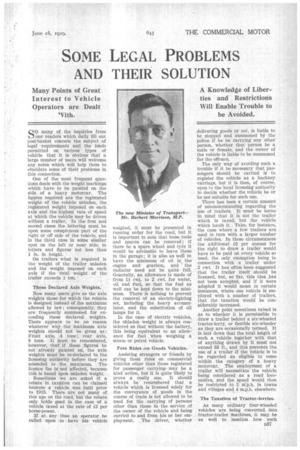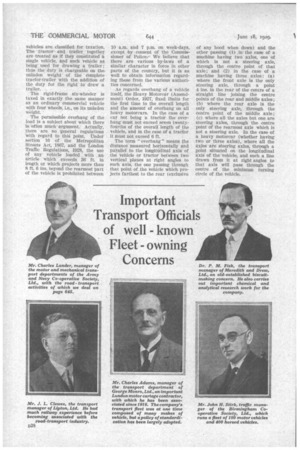SOME LEGAL PROBLEMS AND THEIR SOLUTION
Page 115

Page 116

If you've noticed an error in this article please click here to report it so we can fix it.
S0 many of the inquiries from our readers which daily fill our post-basket concern the subject of legal ,requirements and the loads permitted on various types of vehicle that it is obvious that a large number of users will welcome any notes -which will help them to elucidate some of their problems in this connection.
One of the most frequent questions deals with the weight markings which have to be painted on the side of a heavy motorcar. The figures required are the registered weight of the vehicle unladen, the registered weight imposed on each axle and the highest rate of speed at which the vehicle may be driven without a trailer. In the first and second cases the lettering must be upon some conspicuous part of the right or off Side of the vehicle, and in the third case in some similar spot on the left or near side, in letters and figures not less than I in. in height.
On trailers what is required is the weight of the trailer unladen and the weight imposed on each axle if the total weight of the trailer exceeds 1 ton.
Those Declared Axle Weights..
Now many users give as the axle weights those for which the vehicle is designed instead of the maximum allowed by law; consequently, they are frequently summoned for exceeding these declared weights. There appears to be no reason whatever why the maximum axle weights should not be given as ; Front axle, 4 tons; rear axle, 8 tons. It must be remembered, however, that if these figures be• not already painted on, the axle weights must be re-declared to the licensing authority before they are amended to the maximum. The licence fee is not affected, because this is based upon unladen weight.
Sometimes we are asked if a rebate in taxation can be claimed because a vehicle was built prior to 1913. There are not many of this age on the road, but the rebate only holds good in the case of a vehicle taxed at the rate of Ll per horse-power.
If at any time an operator be called upon to have his vehicle weighed, it must be presented in running order for the road, but it is important to note that loose tools and spares can be removed ; if there be a spare wheel and tyre it would be advisable to leave these in the garage; it is also as well to have the minimum of oil in the engine and gearbox, and the radiator need not be quite full. Generally, an allowance is made of from 1i cwt. to 2 cwt. for water, oil and fuel, so that the fuel as well can be kept down to the minimum. There is nothing to prevent the removal of an electric-lighting set, including the heavy accunaulater, and the substitution of oil lamps for it.
In the case of electric vehicles, the uhladen weight is always considered as that without the battery, this being equivalent to an allowance for fuel when weighing a steam or petrol vehicle.
Free Rides on Goods Vehicles.
Assisting strangers or friends by giving them rides on commercial vehicles other than those registered for passenger carrying.. may be a kind action, but it is quite likely to prove a costly one. It should always be remembered that a vehicle which is licensed solely for the conveyance of goods in the course of trade is not allowed to be used for the carrying of persons other than those in the service of the owner of the vehicle and being carried to and from his or her employment. The driver, whether delivering goods or not, is liable to be stopped and summoned by the police if he be carrying any other person, whether that person be a male or female, and the owner of the vehicle is liable to be summoned for the offence.
The only way of avoiding such a trouble if it be necessary that Passengers should be carried is to register the vehicle as a hackney carriage, but it is then, of course, open to the local licensing authority to decide whether the vehicle be or be not suitable for such use.
There has been a certain amount of misunderstanding regarding the use of trailers. It must be borne in mind that it is not the trailer which is taxed, but the vehicle which hauls it. Take, for instance, the case where a few trailers are used in turn with a larger number of vehicles. In these circumstances the additional £6 per annum for the right to draw a trailer would have to be paid on every vehicle so used, the only exemption being in connection with a trailer under 2 cwt. It has often been suggested that the trailer itself should be licensed, hut, so far, this idea ,bas not been accepted, and if it were adopted it would mean in certain instances, where one vehicle is employed with a number of trailers, that the taxation would be considerably increased.
Another point sometimes raised is as to whether it is permissible to draw a trailer behind a six-wheeled tractor-lorry, or flexible six-wheeler as they are occasionally termed. It is laid down that the total length of such a vehicle together with that of anything drawn by it must not exceed 33 ft., and this prevents the use of a trailer if the vehicle is to be regarded as eligible to come within the category of a heavy motorcar. The employment of a trailer will necessitate the vehicle being considered an a road locomotive, and the speed would then be restricted to 2 m.p.h. in towns and villages and 4 m.p.h. elsewhere.
The Taxation of Tractor-lorries.
As many ordinary four-wheeled vehicles •are, being converted into tractor-trailer Machines, it may be as well to mention how such vehicles, are classified for taxation. The tractor and trailer together are treated as if they constituted a single vehicle, and such vehicle as being used for drawing a trailer; thus the duty is chargeable on the unladen weight of the complete tractor-trailer with the addition of the duty for the right to draw a trailer.
• The rigid-frame six-wheeler is taxed in exactly the same manner as an ordinary commercial vehicle with four wheels, i.e., on its unladen weight.
The permissible overhang of the load is a subject about which there is often much argument. Actually, there are no general regulations with regard to this point. Under section 16 of the Metropolitan Streets Act, 1867, and the London Traffic Regulations, 1928, the use of any vehicle loaded with an article which exceeds 36 ft. in length or which .projects more than. 8 ft. 6 ins, beyond the rearmost part of the vehicle is prohibited between 10 a.m. and 7 p.m. on week-days, except by consent of the Commissioner of Police.We believe that there are various by-laws of a similar character in force in other parts of the country, but it is as well to obtain information regarding these from the various authorities concerned.
As regards overhang of a vehicle itself, the Heavy Motorcar (Amendment) Order, 1927, fixed limits for the first time to the overall length and the amount of overhang on all heavy motorcars. In the case of a car not being a tractor the overhang must not exceed seven twentyfourths of the overall length of the vehicle, and in the case of a tractor it must not exceed 6 ft.
The term " overhang " means the distance measured horizontally and parallel to the longitudinal axis of the vehicle or tractor between two vertical planes at right angles to such axis, the one passing through that point of the vehicle which projects farthest to the rear (exclusive of any hood when down) and the other passing (1) in the ease of a machine having two axles, one of which is not a steering axle, through the centre point of that axle; and (2) in the ease of a machine having three axles : (a) where the front axle is the only steering axle, through a point 4 ins, in the rear of the centre of a straight line joining the centre points of the rear and middle axles; (b) where the rear axle is the only steering axle, through the centre point of the middle axle; (c) where all the axles but one are steering axles, through the centre point of the rearmost axle which is not a steering axle. In the case of a heavy motorcar (whether having two or three axles), where all the axles are steering axles, through a point situated on the longitudinal axis of the vehicle, and such a line drawn from it at right angles to that axis will pass through the centre of the minimum turning circle of the vehicle.








































































































































































































